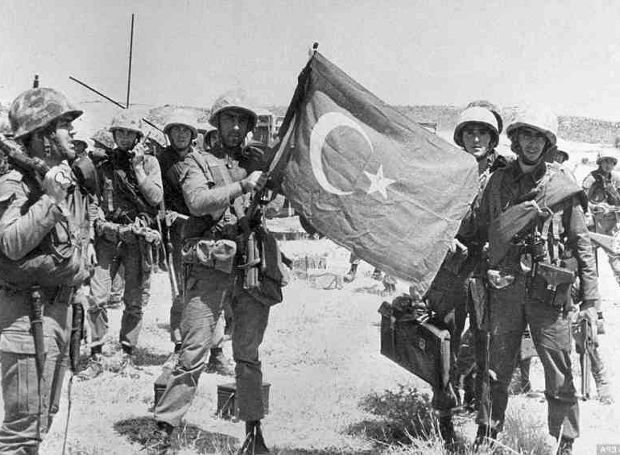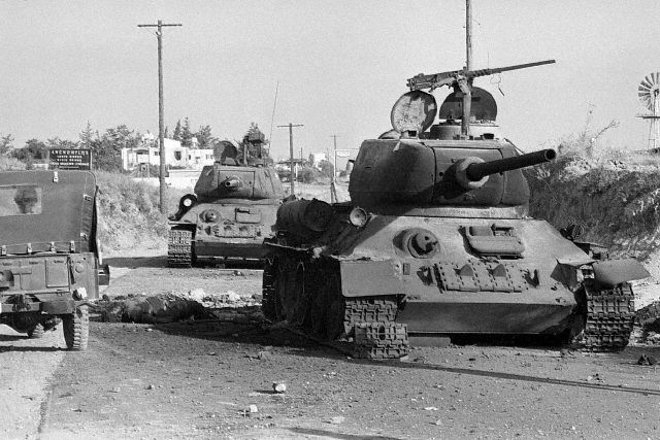
Yet, Turkey argued that it was not an invasion, but a “peaceful intervention” aimed at restoring the constitutional order in Cyprus, which had been upturned only five days earlier by the coup against the President of the Cyprus Republic, Archbishop Makarios.
The failed coup was instigated by the Greek Junta of the time and Cypriot nationalists who wanted to see the island united with Greece. As it turned out, it served as a great opportunity for Turkey to send troops to take over the northern part of Cyprus.
Thousands of Turkish soldiers began to disembark unobstructed from deck boats at the Pente Mili coast, eight kilometers west of Kyrenia, shortly after 5 am on July 20. At the same time, Turkish warplanes attacked the wider Kyrenia and Nicosia regions, while other aircraft dropped paratroopers to strategic sites. Area residents were at the mercy of the invaders. Unarmed citizens were murdered, women raped, and captive soldiers executed.
The reaction of the Greek Cypriot side was inexplicably late. Although the Greek Pentagon knew the movements of the Turkish armed forces, they thought they were bluffing. It was only at 8:40 in the morning that Athens was officially given the mandate to implement war plans, while Greek radio reported the news at around 11 am. The delayed reaction allowed the Turkish invading forces to consolidate their positions and create a bridgehead from Pente Mili of Kyrenia to Agios Ilarionas, having as objective the connection with the Turkish Cypriot enclave of Nicosia.
The units of the National Guard and the Hellenic Force in Cyprus (ELDYK) resisted with heroic self-sacrifice without even having support from the air and modern weapons. They numbered around 12,000 men (Greek Cypriots and Greeks), under the command of Colonel Michael Georgitsis, who had the general command of the coup against Makarios. In the meantime, the Greek Cypriot male population began to mobilize and participate in the unequal struggle with what everyone had, shooting from the roofs of their homes against invading paratroopers.
Late in the evening, the UN Security Council issued Resolution 353 calling for a ceasefire and a withdrawal from Cyprus of “foreign military powers.” Despite its unanimous approval, it is ignored by Turkey, which urgently needs to implement its plans. Generally speaking, the international reaction to “Attila” was rather lukewarm.
The following day, July 21, the battles in Cyprus continued to be very intense. The aim of the Greek forces in Cyprus is to cut off the Turkish Cypriot enclave of Nicosia from the Kyrenia bridgehead. Greek generals reject a suggestion for intervention in Cyprus, predicting failure of the project. Two Greek submarines sailing to Kyrenia are ordered to return to Greece.

Meanwhile, U.S. State Department Deputy Joseph Sisco moves between Athens and Ankara. In Athens he finds no one to negotiate as dictator Dimitrios Ioannidis has lost control of the army and his cabinet is in disarray after the failed coup and the Turkish invasion. Greek Navy chief, Admiral Petros Arapakis, has a telephone conversation with State Department Secretary Henry Kissinger and agree that a ceasefire will be in force from 4 am on July 22.
At 2 am on July 22, 12 Greek Noratlas transporters, carrying commandos to the island, were inadvertently hit by friendly fire near Nicosia airport. One of them was shot down (4 crew members and 27 commandos lost their lives), while two others suffered serious damage. On the same day, Turkish invaders stepped up operations. Navy carriers transported tanks to Cyprus and by noon they occupied the city of Kyrenia.
At 4 o’clock in the afternoon, the two sides adhere to the ceasefire. However, the invading forces violated the ceasefire several times. At that point, the Turkish army controlled 3% of the territory of Cyprus, having created a bridgehead linking Kyrenia with the Turkish Cypriot enclave of Nicosia.
Today, 35,000 Turkish troops are on the northern part of the island to protect the Turkish Cypriot population, as Ankara claims.
See all the latest news from Greece and the world at Greekreporter.com. Contact our newsroom to report an update or send your story, photos and videos. Follow GR on Google News and subscribe here to our daily email!



